Jaunųjų mokslininkų darbai eISSN 1648-8776
2021, vol. 51, nr. 2, pp. 58–71 DOI: https://doi.org/10.15388/JMD.2021.16
Investigation of the Physical Properties of a Fabric with a Conductive Fibre
Audinio su laidžiu pluoštu fizikinių savybių tyrimas
Virginija Sacevičienė
Kaunas University of Technology
E. p. virginija.saceviciene@ktu.lt
Ramunė Klevaitytė
Šiauliai Academy
E. p. ramune.klevaityte@su.lt
Svetlana Radavičienė
Granberg AS
E. p. svetlana.radaviciene@gmail.com
Virginijus Urbelis
Granberg AS
E. p. virginijus.urbelis@granberg.lt
Summary. The aim of this work is to investigate physical and mechanical performance of fabrics with a conductive fibre after washing conditions. Three commercially available fabrics with a conductive fibre and one fabric without a conductive fibre were chosen as a research object. The physical properties of the fabrics were evaluated by the loss of the mechanical performance, changes in structure and magnetic permeability. Fabric elasticity and thickness decrease after washing, except for the fabric without a conductive fibre. Magnetic field permeability of all fabrics decreases after washing. The properties of the fabric with a conductive fibre woven in one direction change the most, its magnetic field permeability is the greatest. In all cases magnetic field permeability at the seam is lower than in separate pieces of the fabric. The highest frequency of the fabric with a thread woven in both directions is at the seam but in all cases the frequencies of separate pieces of fabrics are lower. Tests showed that the best dielectric properties are of the fabric with a conductive yarn woven in the weft direction and the highest capacitance change of which is ΔC=74,79%.
Keywords: conductive yarn, magnetic field permeability, dielectric properties of fabric, washing
Santrauka. Šio darbo tikslas yra ištirti medžiagų su laidžiu pluoštu fizines ir mechanines savybes po skalbimo sąlygų. Tyrimo objektu buvo pasirinkti trys komerciniai audiniai su laidžiu pluoštu ir vienas audinys be laidžių pluoštų. Fizinės audinių savybės buvo vertinamos pagal mechaninių savybių pokyčius, struktūros pokyčius ir magnetinį pralaidumą. Audinio elastingumas ir storis po skalbimo sumažėja, išskyrus audinį be laidžių pluoštų, Visų audinių magnetinio lauko pralaidumas po skalbimo sumažėja. Labiausiai keičiasi audinio, kuriame laidus pluoštas yra austas viena kryptimi, savybės: jo magnetinio lauko pralaidumas yra didžiausias. Visais atvejais magnetinio lauko pralaidumas siūlėje yra mažesnis nei atskirose audinio dalyse. Didžiausias magnetinio lauko pralaidumas yra audinio ties siūle, kurio siūlas austas abejomis kryptimis, tačiau visais atvejais atskirų audinių skirtingų vietų elektromagnetiniai dažniai yra mažesni. Tyrimai parodė, kad geriausios dielektrinės savybės yra audinio, kurio siūlas audžiamas ataudų kryptimi ir kurio didžiausias talpos pokytis ΔC = 74,79%.
Raktiniai žodžiai: laidus pluoštas, magnetinio lauko pralaidumas, medžiagų dielektrinės savybės, skalbimas
Received: 2020-10-13. Accepted: 2021-11-23
Copyright © 2021 Virginija Sacevičienė, Ramunė Klevaitytė, Svetlana Radavičienė, Virginijus Urbelis. Published by Vilnius University Press. This is an Open Access article distributed under the terms of the Creative Commons Attribution Licence, which permits unrestricted use, distribution, and reproduction in any medium, provided the original author and source are credited.
Introduction
Antistatic protection and control of static electricity is an important and necessary parameter in a wide range of applications. The main hazard listed in literature is a risk of electrostatic discharge. Materials recommended for protection are those with high electrical conductivity and magnetic permeability. Electromagnetic (EM) interference shielding is an important practical requirement for effective electromagnetic shielding applications, technical applications, especially in the areas of aircraft, aerospace and portable electronics [1]. Electrically conductive materials are widely used in high-risk areas, in explosives or other materials since that may affect both human health and the surrounding environment [2]. Conductive stainless-steel fibre (Inox) can protect the garments from the effects of electromagnetic fields. Silver-coated, X-Static fibre is a good conductor and reduces electromagnetic radiation emitted by phones and home appliances (ACOR). Copper sulfide-coated synthetic fibre (EURO-static) is moisture resistant and retains this property after washing (NCT Europe) [3, 4]. Nega-Stat, polyester bi-component yarn with a carbon core (Shieldex) [3] neutralizes surface charges. There are several different techniques of incorporating electroactive threads into textile fabrics. Conductive yarn can be integrated by weaving [4], knitting using a chain stitch [5], embroidering [6]. Electrostatic properties such as surface resistivity screening, half decay time are determined referring to EN 1149 standard [6-8]. It is known that at sufficiently high frequencies it is possible to evaluate only the electric component of an electromagnetic field, there should be some mathematical correlation between total shielding effectiveness and fabric surface resistivity or conductivity.
Other research into electromagnetic shielding investigates the content and placing of a conductive component [9, 11, 13], geometric structure of a fabric [10, 12, 14]), humidity of textile [7, 12], dependence between electric conductivity and EMSE (electromagnetic shielding effectiveness). Fabric porosity has a very big effect on the shielding factor. The bigger are weft densities of the fabric, the lesser are the values of electrostatic field strength [8]. Such comfort properties as thermal conductivity and air permeability directly depend on a conductive component [9]. Warp-weft density of woven fabrics can affect EMSE depending on electromagnetic wave polarization. A higher weft density means higher EMSE of woven fabrics in case of vertical polarization of electromagnetic waves. Weave type does not affect polarization of electromagnetic waves. Conductive yarn density is an important factor that affects the EMSE of woven fabrics [10, 13, 14]. It is known that fabrics, containing synthetic fibres, can accumulate electric charge in the long term. However, synthetic fabrics containing conductive fibres also accumulate electric charge and, consequently, energy stored in electrostatic fields. The main hazards caused by an ESD (electric discharge) and listed in literature are ignition hazards and damage to electronic devices [11]. Natural fibre affects electromagnetic shielding. It increases shielding effectiveness of fabrics [8]. Electrical properties of fabrics depend not only on nature and structure but also on moisture accumulation capability [12]. The effect of the diameter and content of a conductive fibre on shielding performance was studied and it was found that greater thickness of a conductive fibre gives better shielding values in higher frequency ranges, but stitch density does not affect shielding performance in the frequency range of 300-3000MHz [13].
Manufacturers produce fabrics with parallel electro-conductive fibres woven therein, joined to the electro-conductive surface at overlapping or butt-joined seams in order to form a perfect electrostatic bridge between those pieces and thus to reduce static charging of both, the clothing and the wearer’s body, and avoid dust precipitation if, for example, a component of an electrostatic circuit breaks down [8].
Washing, cleaning or effects within low loading rates change not only fabric structure but also its physical properties. Washing affects surface resistivity. After washing, surface resistivity decreases [7]. Electromagnetic properties can be determined using a non-standardized method and a digital E7-8 device for capacitance measurement [3]. Chemical cleaning significantly decreases the shielding effect [15]. It is known that washing affects not only the surface structure of fabrics but also their mechanical properties [16, 17]. Dependence of fabric thickness on the number of applied washing and drying cycles has been found in many tests [1, 17]. After the first washing and drying cycle fabric thickness significantly increases, from 11% to 18%.
S. Varnaitė and J. Katunskis found that washing does not significantly affect the shielding factor for fabrics with conductive yarn. It was found that vertical electrical resistance and surface resistivity are very sensitive to the quantity of conductive PES/INOX yarn in fabrics. After five washing cycles surface and volume resistivity increased very distinctly. Such a difference in values of vertical resistance may be due to the loss of stainless fibres after washing. It means that half decay time increased, and shielding effectiveness decreased [18]. The electrical resistance of electrically conductive fibres increases with washing until they become non-conductive [19]. Vertical electrical resistance, surface resistivity, shielding factors and half decay time were measured in fabrics before and after 5 washing cycles.
Methods for determining material properties, which could help evaluate the strength of an electric field, are being developed. Practical determination of energy stored in space is limited, because it is necessary to know permittivity distribution and an electric field or the spatial distribution of charge density in this space. Equivalent voltage was measured with a new model system and energy stored in the system was estimated by numerical simulations carried out with COMSOL Multiphysics Software using an electrostatic module. Results of energy estimations based on the analytical model show high compliance with the those obtained from numerical modelling. There was a slight discrepancy between theoretical and practical research. It was found that synthetic fabrics have the ability to store electric charge for a long time even if conductive fibres are incorporated into their structure [11].
The product manufactured from material having a parallel electro-conductive fibre at seams that join pieces of clothing minimizes static charging problems in factories. Research found that more than two layers of material can be combined in an antistatic product. By applying threaded joints of a particular configuration, it is possible to avoid the separation of pieces of individual materials [20].
A patent was developed how to avoid hazards caused by electrostatic charge in industrial plants and what effect washing and electrostatic threads that overlap or do not overlap at the seam have. It is difficult to evaluate the performance of protective clothing made from a core conductive fibre using standard methods. Usually, indirect measurement techniques are used. Measuring technique, developed by Centexbel, shows that under high electric fields some conduction develops inside the sample and that can explain the antistatic effect of the material. This technique is also effective for evaluating electrical conductivity at seams. Using a special device, it is possible to determine the effect of a seam on product conductivity; only very high potential differences were able to produce conduction. It appears that conduction mechanism develops inside some samples, confirming the antistatic effect of the materials in high electric fields. Core conductive fibres would be the most suitable type of conductive fibre for such protective garments where reliable grounding of conductive garment elements is not always obtained [21].
Ferromagnetic properties of electrically conductive garments are important. Conductivity of materials is a characterizing ability to conduct electrical current, and it is important to consider how well a material conducts current. It is just the opposite of resistance. It is defined as the ease with which a substance passes current flow. It is known that at sufficiently high frequencies it is possible to measure characteristics of electrical part of electromagnetic field only and therefore it should be relation between total shielding effectiveness and fabric conductivity [9]. Electrical conductivity models are often proposed to predict the conductivity behavior of material with conductive components to achieve more efficient material design. [27]. Magnetization can be evaluated by using a vibrating magnetometer at room temperature [22]. Magnetic permeability and electrical conductivity of stainless-steel fibre vary with frequency change [23].
To determine the physical properties of materials within low loading rates several different measurements should be carried out. K. Kazanavičius and V. Tričys patented a pneumatic device [24], which works by the principle of two-axis spherical stretching and softness measurement on this basis. Using this method softness was measured by increased elasticity of a material.
The aim of the study – to determine the influence of washing on the physical properties of fabrics and protective clothing containing conductive fibres.
To achieve this goal, the following objectives were set.
1. To review the methods of determining the electromagnetic properties of materials.
2. To evaluate the influence of washing on the electromechanical properties of materials.
3. To evaluate the influence of electromagnetic wire, overlap in the seam on the electromagnetic properties of materials.
Tested fabrics and methodology
Materials
Four commercially available woven materials were selected as a research object. The specifications of these materials are given in Table 1.
Table 1. Structural characteristics of textile fabrics
|
Fabric code |
Yarn content |
Mass per unit |
Thickness, |
Weave structure |
Density, cm-1 |
|
|
warp |
weft |
|||||
|
A1* |
24% PES, |
360 |
0.62 |
Twill |
29 |
20 |
|
A2** |
25% PES. |
320 |
0.32 |
47 |
24 |
|
|
A3*** |
24% PES. |
215 |
0.21 |
48 |
22 |
|
|
A4*** |
24% PES. |
296 |
0.27 |
52 |
27 |
|
*A1 – fabric with conductive yarn woven in the warp-weft directions, the conductive yarn forms a square of 10x10 mm
**A2 – fabric without conductive yarn
***A3, A4 – fabric with conductive yarn woven in the weft direction at the interval of 10 mm

Figure 1. The view of fabric A1 structure and thickness of conductive yarn
The structure of yarn and a conductive filament are given in Figure 1. As is seen, the yarn is composed of 5 plies. The thickness of the individual single filaments varied around 24 µm.
Materials system
Two types of fabric with conductive yarn samples were tested: when conductive yarn overlaps at the seam (see Fig. 2 b) and does not overlap at the seam (see Fig. 2 a)
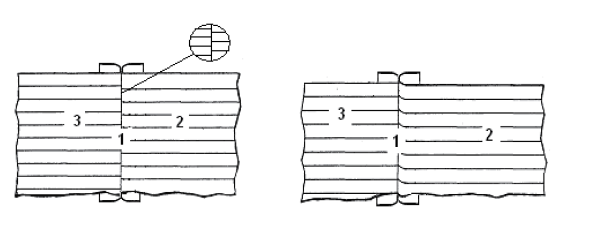
Figure 2. Scheme of preparing and evaluating seam joints: a) conductive yarn does not overlap at the seam. b) conductive yarn overlaps at the seam. Numbers 1, 2, 3 – measuring parts for electromagnetic properties
Seam system: N – conductive yarn does not overlap at the seam, S – conductive yarn overlaps at the seam. Measurements were performed in three places: 1 – at the seam, 2 and 3 – on different sides of the seam in different parts of the material samples.
Methods
Washing procedure
Fabrics were washed referring to LST EN ISO 6330:2002 standard under 40°C. This international standard specifies domestic washing and drying procedures for textile testing. The procedures are applicable to textile fabrics for garments or other textile articles which are subjected to appropriate domestic washing and drying procedures.
Various non-destructive methods are used to evaluate the structure properties of fabrics. One of them is under the influence of thickness h change.
 (1)
(1)
h1 – fabric thickness before washing, (mm) h2 – fabric thickness after washing (mm).
Mechanical properties
It is very important to know how the electromagnetic properties of a product change within low loads. Such changes determine the continued development of new test methods. The essence of these methods is that the specimen is deformed symmetrically operating conditions corresponding to loads.
Mechanical properties were investigated using a pneumatic two-axis spherical stretching device (see Fig. 3) [24].
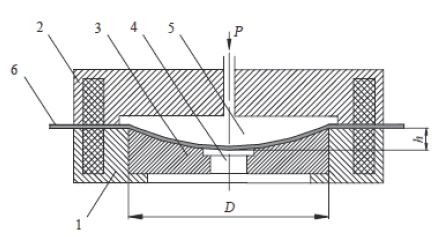
Figure 3. Scheme of a pneumatic device: 1, 2 – electromagnets, 3 – spherical matrix, 4 – sensor, 5 – pneumatic unit, 6 – test sample [24]
It is used to measure sample elasticity expressed by pressure needed to reach a conditional stretch of 2.6%. A similar deformation of 2.7% can also be reached using a device patented by Prof. M. Gutauskas [26]. The samples of tested materials are placed on an electromagnet 1 with a spherical matrix (see Fig. 3) and pressed under an upper electromagnet 2 with a pneumatic unit 5. When the device is switched on, pressure raised in the unit deforms the sample. Sensor 4 signals a reached needed deformation value h, a digital pressure meter registers a pressure value. Using this method fabric elasticity was calculated in dependence of the pressure P (Fig.3). P value used in the calculations was determined at the moment when the upper surface of the sample contacts a sensor 4 at the height h. At this moment relative elasticity of 2.6% is reached (constant of the device). Based on the experimental results, the geometrical parameters ((D – Poisson working surface diameter) and h)) of the pneumatic device can be calculated [24].
 (2)
(2)
where P is the pressure in the unit of the device, MPa; P1 is the calculated pressure constant, at which stress of 1 MPa is reached.
Differences of fabric elasticity is determined:
 (3)
(3)
S1 – elasticity of the sample before washing mm/Hg; S2 – elasticity of the sample after washing mm/Hg.
Ferromagnetic and magnetic properties
Ferromagnetic properties were tested carrying out three types of tests and using special devices.
Changes in magnetic charge of the tested material (changes in magnetic field conductivity of differently treated samples of similar thickness, see Fig. 4) are determined by measuring the related electrical parameters: induced voltages U and generated frequency f.
Induced voltage is determined:
Δu = UASn – UANn (4)
UASn – induced voltage of the sample with conductive yarn that overlaps at the seam (V), UANn – induced voltage of the sample with conductive yarn that does not overlap at the seam (V)
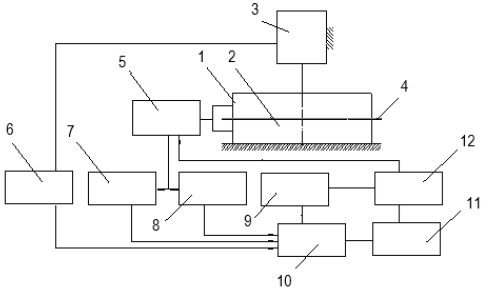
Figure 4. Scheme of the device for testing ferromagnetic properties (the author of the scheme is K. Kazanavičius): 1 – receiver, 2 – induction coil in a frequency generator, 3 – thickness measurement sensor, 4 – fabric sample, 5 – switchboard, 6 – measured value, 7 – digital LC indicator, 8 – tension sensor, 9 – frequency sensor, 10 – indicator, 11 – DC adapter, 12 – frequency generator
Induced tension and frequency differences when conductive yarn overlaps and does not overlap at the seam in the fabric are determined:
Δf = fASn – fANn (5)
fASn – induced frequency of the sample with conductive yarn that overlaps at the seam (Hz), fANn – induced frequency of the sample with conductive yarn that does not overlap at the seam (Hz)
Changes in magnetic charge (changes in magnetic field conductivity of differently treated samples of similar thickness) (see Fig. 5) are determined by measuring a related electrical parameter – inductivity L. Initial inductivity of the device – 1.583 H.
L = L0 – L1 (6)
L0 – initial inductivity of the device (H), L1 – measured induction of the samples (H).
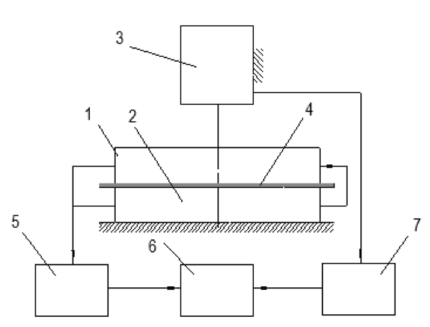
Figure 5. Scheme of the device for testing magnetic properties (the author of the scheme is K. Kazanavičius): 1, 2 – induction coils, 3 – thickness measurement sensor, 4 – fabric sample, 5 – digital LC, 6 – indicator, 7 – measured value
Differences in fabric inductivity before and after washing (ΔLw) are determined:
 (7)
(7)
L1 – fabric inductivity before washing (H), L2 – fabric inductivity after washing (H).
Changes in the dielectric properties of the samples (see Fig. 5, capacitor with additional plates and a capacitive sensor) are determined by measuring capacitance C. Initial capacitance of the device – 1.807 nF.
C = C1 – C0 (8)
C0 – initial capacitance of the device (nF), C1 – measured initial capacitance of the samples (nF).
Differences between the capacitances of fabrics before and after washing are determined:
 (9)
(9)
C1 – measured initial capacitance of fabrics (nF), C2 – capacitance of fabrics after washing (nF).
Research findings and methodology
Elasticity and thickness after washing
Washing had an impact on the structure and elastic properties of the test fabrics. As can be seen from the figure 3, the values obtained by the device (Figure 3) for determining the elasticity suggest that the elastic properties of all fabrics decreased, except for fabric A2 without an electric thread, the elastic properties of which increased. The biggest change in elasticity is 16,05% for fabric A2 without conductive yarn, and the smallest change in elasticity is for fabric A3.
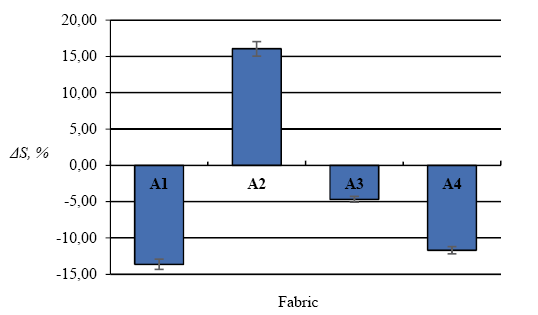
Figure 6. Change in fabric elasticity after washing

Figure 7. Change in fabric thickness after washing
Thickness of all fabrics significantly decreased, except for fabric A2 without conductive yarn (see Fig. 7). As it is seen in Figure 7, the biggest change, of 15.5%, is in the fabric with an electrostatic thread woven in the weft direction, the smallest, of 0.36%, – without an electrostatic thread. The biggest change is in the fabric with conductive yarn woven in one direction. Similar results were obtained by other researchers [1, 17].
Magnetic and ferromagnetic properties
Having evaluated magnetic field permeability (see Table 2) of the fabric with a thread woven in the weft direction we can see that the place of measurement has no effect because induced voltage almost does not change and ranges from 0 to 0.00 1V; tension changes insignificantly, from 0 to 0.007 V, when a thread has been woven in both directions.
Table 2. Characteristics of magnetic field permeability by measuring tension and frequency parameters
|
Fabric |
Thickness, mm |
U, V |
F, kHz |
∆U, V |
∆F, kHz |
|
AS1-1 |
1.456 |
0.108 |
2.209 |
0.007 |
-0.077 |
|
AS1-2 |
0.343 |
0.133 |
1.862 |
0 |
0.012 |
|
AS1-3 |
0.298 |
0.134 |
1.847 |
0.001 |
0.002 |
|
AN1-1 |
1.827 |
0.101 |
2.286 |
- |
- |
|
AN1-2 |
0.342 |
0.133 |
1.850 |
- |
- |
|
AN1-3 |
0.355 |
0.133 |
1.845 |
- |
- |
|
AS4-1 |
1.112 |
0.115 |
2.104 |
0.001 |
0.027 |
|
AS4-2 |
0.324 |
0.135 |
1.799 |
0.001 |
0.024 |
|
AS4-3 |
0.310 |
0.135 |
1.781 |
0.001 |
-0.01 |
|
AN4-1 |
1.256 |
0.116 |
2.077 |
- |
- |
|
AN4-2 |
0.480 |
0.136 |
1.775 |
- |
- |
|
AN4-3 |
0.316 |
0.136 |
1.791 |
- |
- |
AS1-1, 2, 3 – fabric A1 with conductive threads overlapping in the seam and 1, 2 and 3 – measurement location according to the scheme (Figure 2, b), in the seam; AS4-1, 2 and 3 – fabric A4 with conductive threads overlapping in the seam and 1, 2 and 3 -–measurement location according to the scheme (Figure 2, b), AN1-1, 2, 3 – fabric A1 with conductive threads not overlapping in the seam and 1, 2, 3 – measurement location according to the scheme (Figure 2, a), in the seam, AS4-1, 2, 3 – fabric A4 with conductive threads not overlapping in the seam and 1, 2 and 3 – measurement location according to the scheme (Figure 2, a), in the seam.
In all cases magnetic field permeability at the seam is lower than in separate pieces of fabric. The highest difference of frequency at the seam is 0.077V, when a thread has been woven in both directions, but in all cases the lowest frequencies are in separate pieces of fabrics.
The induction of the joined pieces of fabric (see Table 3) was found to be greatest when the conductive yarn was woven in both directions and did not overlap. The lowest induction at the seam of various materials ranges from 1.313H to 1.382H, but the fabric with conductive yarn woven in the weft direction demonstrates higher values. Changes in separate pieces of the fabric are insignificant, from 1.550H to 1.572H.
Table 3. Comparison of fabric inductance
|
Fabric |
AS1-1 |
AS1-2 |
AS1-3 |
AN1-1 |
AN1-2 |
AN1-3 |
AS4-1 |
AS4-2 |
AS4-3 |
AN4-1 |
AN4-2 |
AN4-3 |
|
L1, H |
1.329 |
1.551 |
1.552 |
1.313 |
1.545 |
1.546 |
1.360 |
1.556 |
1.550 |
1.382 |
1.553 |
1.551 |
|
∆L, H |
0.254 |
0.032 |
0.031 |
0.27 |
0.038 |
0.037 |
0.223 |
0.027 |
0.033 |
0.201 |
0.03 |
0.032 |
|
∆Lw, % |
19.11 |
2.06 |
1.99 |
20.56 |
2.46 |
2.39 |
16.4 |
1.73 |
2.13 |
14.50 |
1.93 |
2.06 |
Magnetic field permeability of all fabrics decreased after washing (see Fig. 8). The highest change of permeability (ΔLw=27.5%) was of fabric A4 with conductive yarn woven in the weft direction, the lowest (ΔLw =2.44%) – of fabric A2 without conductive yarn.
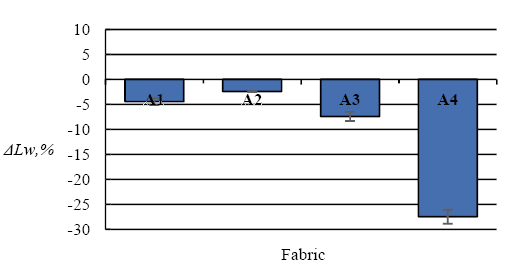
Figure 8. Change of magnetic permeability (ΔLw) values of fabric by measuring the induction parameter before and after washing
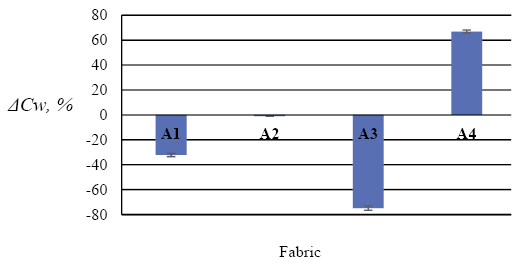
Figure 9. Change of conductivity (ΔCw) values of fabric by measuring the induction parameter before and after washing
As evident from Fig. 9, washing affected the conductivity of materials with conductive yarn. Fabric A3 with conductive yarn woven in the weft direction has the best dielectric properties, and fabric A2 without conductive yarn is with the lowest capacitance of C=1,49% – the worst dielectric properties.
Conclusions
1. The elasticity of the fabric decreased from 4.5% to 12.0%, except for fabric A2 without an electric thread, the elastic properties of which increased to 19.1% and thickness of all the fabrics decreased from 0.4% to 15.5% after washing.
2. The magnetic field permeability of all examined fabrics decreased from 2.44% to 27.5% for different materials after washing.
3. The measurement location does not affect the magnitude of the magnetic field.
4. In all cases, the permeability of the magnetic field in the seam is about 15 percent lower than in individual parts of the fabric.
5. The highest frequency of the fabric with conductive yarn woven in both directions is at the seam, however, in all cases, the frequencies of individual fabric sections are lower.
6. The conductivity of the joined fabric pieces was found to be high when the conductive yarn was woven with both directions, but higher conductivity was obtained when the conductive yarns were woven in only one direction. It has been found that a fabric whose conductive yarns are woven in the weft direction has the best dielectric properties.
Acknowledgement
The authors would like to thank Assoc. Prof. K. Kazanavičius and student S. Kariackaitė for their assistance in performing this research work.
References
1. Tunáková V., Techniková L., Militký J., 2017, Influence of Washing/drying Cycles on Fundamental Properties of Metal Fiber-containing Fabrics Designed for Electromagnetic Shielding Purposes, Textile Research Journal, Vol. 87, P. 175-192.
2. Truncytė D., Gutauskas M., Baltušnikas A., 2008, The Peculiarities of Clothing Fabrics During Exploitational Behavior, Materials Science (Medžiagotyra) , Vol. 14, P. 263-267.
3. Varnaitė-Žuravliova S., Stygienė L., Čepliauskienė R., Krauledas S., Sankauskaitė A., 2013, The Influence of Three-Layer Knitted Fabricsʼ Structure on Electrostatic and Comfort Properties, Materials Science (Medžiagotyra) , Vol. 19, P. 415-419.
4. Varnaitė S., Vitkauskas A., Abraitienė A., Rubežienė V., Valienė V., 2008, The Features of Electric Charge Decay in the Polyester Fabric Containing Metal Fibres, Materials Science (Medžiagotyra) , Vol. 14, P. 157-161.
5. Strazdienė E., Blaževič P., Vegys A., Dapkūnienė K., 2007, New Tendencies of Wearable Electronics Application in Smart Clothing, Electronics and Electrical Engineering, Vol. 73, P. 21-24.
6. Juchnevičienė Ž., Briedis U., Vališevskis A., Jucienė M., Dobilaitė V., Sacevičienė V., 2018, Electrical Conductivity of a Closed-circuit Embroidery Element, Proceedings of the Estonian Academy of Sciences, Vol. 67, P. 158-164.
7. Hainš N., Friščić V., Gordoš D., 2003, Testing Electrostatic Properties of Polyurethane Coated Textiles Used for Protective Clothing, International Journal of Clothing Science and Technology, Vol. 15, P. 250-257.
8. Varnaitė S., 2010, The Use of Conductive Yarns in Woven Fabric for Protection Against Electrostatic Field, Materials Science (Medžiagotyra ), Vol. 16, P. 133-137.
9. Safarova V., Militký J., 2013, Electromagnetic Field Shielding Fabrics with Increased Comfort Properties, Advanced Materials Research, Vol. 677, P. 161-168.
10. Ortlek H. G., Saracoglu O. G., Saritas O., Bilgin S., 2012, Electromagnetic Shielding Characteristics of Woven Fabrics Made of Hybrid Yarns Containing Metal Wire, Fibres and Polymers, Vol. 13, P. 63-67.
11. Kacprzyk R., Krόl J., Pelesz A., 2018, Energy Stored in the Electric Field Produced by a Charged Fabric with a Conductive Mesh, FIBRES &TEXTILES in Eastern Europe, Vol. 26, P. 52-58.
12. Jankauskaitė V., Gulbinienė A., Kondratas A., Domskienė J., Urbelis V., 2018, Influence of the Structure of Footwear Upper and Lining Materials on Their Electrical Properties, FIBRES &TEXTILES in Eastern Europe, Vol. 26, P. 87-92.
13. Soyaslan D., Çömlekçi S., Göktepe Ö., 2010, Determination of Electromagnetic Shielding Performance of Plain Knitting and 1X1 Rib Structures with Coaxial Test Relating to ASTM D4935, Journal of Textile Institute, Vol.101, P. 890-897.
14. Li Y., Wang X., Pan Z., Su Y., Liu Z., Duan J., Li Y., 2019, Analysis of Shielding Effectiveness in Different Kinds of Electromagnetic Shielding Fabrics under Different Test Conditions, Textile Research Journal, Vol. 89, P. 375-388.
15. Šaravanja B., Malarić K., Pušić T., Ujević D., 2015, Impact of Dry Cleaning on the Electromagnetic Shield Characteristics of Interlining Fabric, FIBRES &TEXTILES in Eastern Europe, Vol. 23, P. 104-108.
16. Masteikaitė V., Smailova U., Nurzhasarova M., Sacevičienė V., Kleveckas T., 2014, Evaluation of Cellulosic Fabrics Surface Characteristics after Different Treatments, Materials Science (Medžiagotyra) , Vol. 20, P. 315-320.
17. Juciene M., Urbelis V., Juchnevičiene Ž., Saceviciene V., Dobilaite V., 2018, The Influence of Laser Treatment and Industrial Washing on Denim Fabric Tension Properties, International Journal of Clothing Science and Technology, Vol. 30, P. 588-596.
18. Varnaitė S., Katunskis J., 2009, Influence of Washing on the Electric Charge Decay of Fabrics with Conductive Yarns, FIBRES &TEXTILES in Eastern Europe, Vol. 17, P. 69-75.
19. Baribina N., Baltina I., Oks A., 2018, Application of Additional Coating for Conductive Yarns Protection against Washing, Engineering Materials, Vol. 762, P. 396-401.
20. Ono K., Okoshi K., 1985, US Patent 4546497.
21. Kalliohaka T., Paasi J., Lemaire P., 2005, Forced Corona Method for the Evaluation of Fabrics with Conductive Fibres, Journal of Electrostatics, Vol. 63, P. 583-588.
22. Mirjalili M., 2016, Preparation of Electroconductive, Magnetic, Antibacterial, and Ultraviolet-blocking Cotton Fabric Using Reduced Graphene Oxide Nanosheets and Magnetite Nanoparticles, Fibres and Polymers, Vol. 17, P. 1579-1588.
23. Liu Z., Zhang Y., Rong X., Wang X., 2015, Influence of Metal Fibre Content of Blended Electromagnetic Shielding Fabric on Shielding Effectiveness Considering Fabric Weave, FIBRES &TEXTILES in Eastern Europe, Vol. 23, P. 83-87.
24. Kazanavičius K., Tričys V., 2008, Evaluation of Leather Softness, Materials Science (Medžiagotyra), Vol. 14, P. 179-182.
25. LST EN ISO 6330:2012, Domestic washing and drying procedures for textile testing, P. 19.
26. Masteikaitė V., Sacevičienė V., 2007, The Influence of Clothes Wear Factors on the Bending Rigidity of Laminates, In 3rd International Technical Textiles Congress: Istanbul, Turkey, P. 446-454.
27. Šafářová V., Miliký J., 2012, A Study of Electrical Conductivity of Hybrid Yarns Containing Metal Fibers, Journal of Materials Science and Engineering B 2, Vol. 2, P. 197- 202.